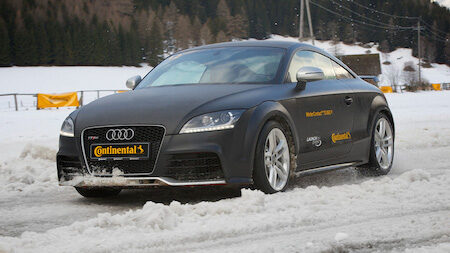As motoring journalists, we live a pretty blessed existence travelling across Europe to test out the very latest models in the most exotic locations.
But it was on a recent trip to Salzburg, Austria that my eyes were really opened because it was my first tyre launch courtesy of Continental, which was introducing its latest winter tyres. In the UK, the number of motorists that change their tyres during the colder winter months is said to be as low as five per cent, but after track testing on packed snow and ice, and some braking and traction experiments, I was certainly converted.
Each year, we sit through numerous press presentations and hear from premium manufacturers about the latest safety innovations and Euro NCAP ratings, but after a few hours in Austria it became very apparent that most safety features are severely compromised in winter if the vehicle is fitted with summer treads.
Tyre production is certainly a complex business – there are all sorts of groove designs known as sipes and compound mixtures comprising natural and synthetic rubber, anti-aging agents, mineral oils and plenty of highly secretive concoctions. The compounds are softer for winter and harder for summer driving conditions and the technicians are put under constant pressure to produce tyres that are not only safe, but deliver precise handling, offer excellent grip on snow, good water dispersion, low noise levels, stability at high speeds and short stopping distances. Basically, we want it all – the safest possible tyres without any compromise on comfort or performance.
And in launching the Continental WinterContact TS 850 P which can be fitted on 17-inch wheels upwards and high performance cars and the Continental WinterContact TS 850 P SUV for sports utility vehicles, it became very apparent how far Continental has come since developing its first winter tyres back in 1952.
To demonstrate the excellent grip, a number of Audi TT RS and BMW 3-Series models were driven around a snow and ice track weaving between cones … at speed. The control was virtually flawless.

Acceleration and traction demonstrations showed how two identical Audi A4 models coped sprinting 20 metres from standstill. One had 4mm tread and took nine seconds, the other had 8mm tread and took under five seconds. BMW X1 models were used to highlight braking distances.
The one fitted with a lesser performance tyre was pushed to 50km/h and then took 30 meters to stop. The one fitted with the Continental tyre took 25 meters to stop. Those five meters could be the difference between life and death. All these tests, experiments and demonstrations proved one thing – you can’t reinvent the wheel, but you can certainly make it turn and stop as safely as possible
Maxine has more than 30 years’ experience in journalism and has been specialising in motoring for the last 18 years, so fulfilling a life-long passion. It gives her the chance to drive all the new models both here in the UK and overseas, as well as interviewing the specialists and engineers behind the very latest innovative technology. Maxine has written for national and regional newspapers, specialist magazines, leading websites and also completed assignments in broadcasting.

